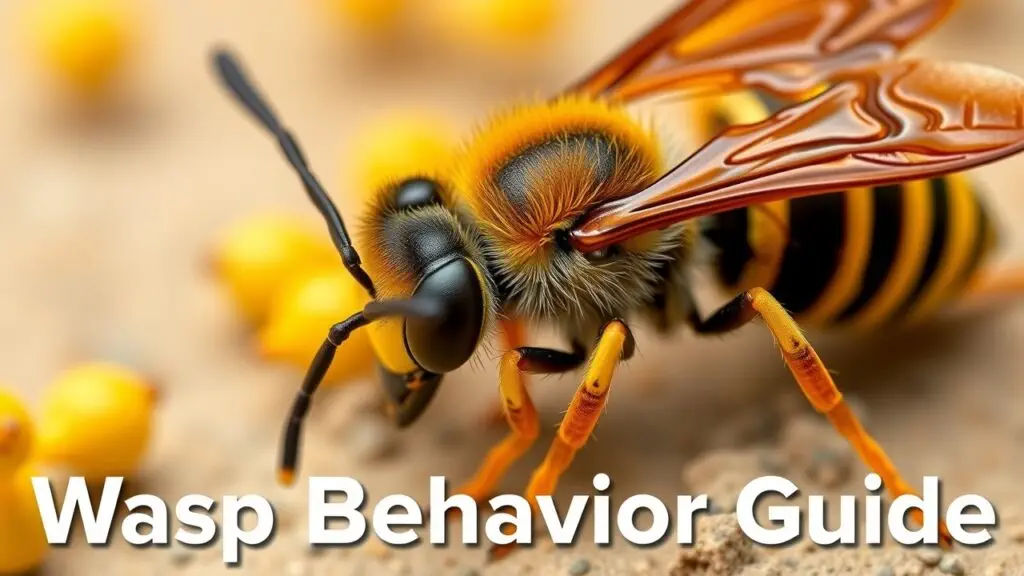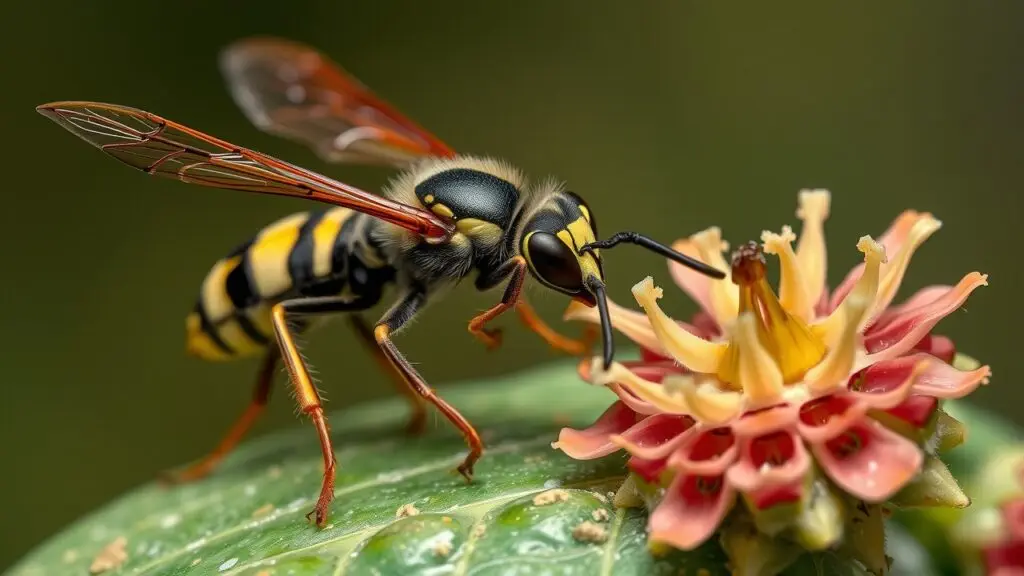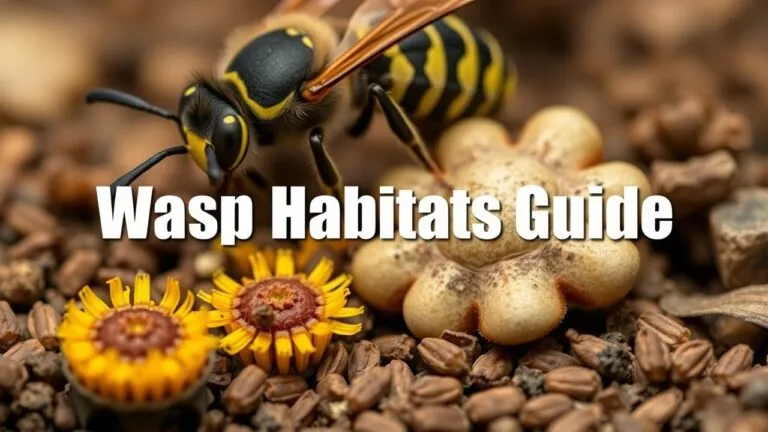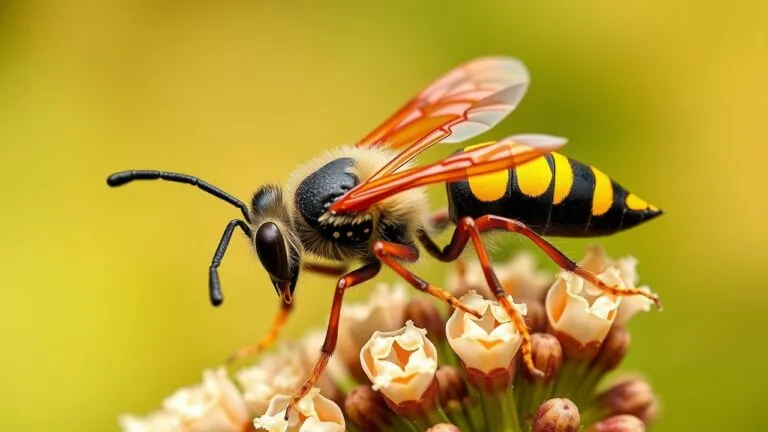This guide explores types of wasp behavior, covering aggression levels across various wasp species, including bees and hornets. Learn about their diets and habitats to better understand and control wasp populations.
What Are Wasps and How Do They Differ From Other Stinging Insects?

Wasps are insects in the order Hymenoptera. This group also includes bees and hornets. While bees mainly eat nectar and pollen, wasps often act as predators or parasites. This means they help control pest populations. Knowing about wasp behavior is important for homeowners and gardeners. It helps them manage these insects more effectively.
Key Differences Between Wasps, Bees, and Hornets
These insects may look similar, but they have distinct differences. Here’s a quick comparison:
| Feature | Wasps | Bees | Hornets |
|---|---|---|---|
| Body Structure | Slim with smooth bodies | Sturdy with hairy bodies | Bigger than typical wasps |
| Diet | Predators or scavengers | Nectar and pollen | Predatory; feeds on other insects |
| Nesting Habits | Paper-like nests (Vespidae) | Wax-based hives | Similar to wasp nests but larger |
| Social Behavior | Can be social or solitary | Mainly social | Highly social |
Understanding these differences helps in recognizing the behavior of each insect type.
Why Is Understanding Wasp Behavior Important?
Knowing how wasps behave is key for several reasons. Pest control experts need to identify different wasp activities to create effective management plans that keep people safe while protecting helpful species. Homeowners gain from understanding how to coexist safely with these insects instead of using harmful extermination methods.
Importance for Homeowners and Gardeners
Homeowners and gardeners need to know about safety with wasps. Recognizing when a nest might be dangerous allows them to act wisely—like avoiding areas during busy times or calling for professional help when needed. Plus, understanding garden ecology shows how some wasps can actually help by eating pests that harm plants.
Ecological Roles as Pollinators and Predators
Wasps have important jobs in nature beyond being annoying. Many species act as natural pest control agents by hunting caterpillars and other harmful bugs that threaten crops. Some types of wasps even help pollinate plants like bees do, even if it’s not as well-known.
Safety Considerations Regarding Stings and Nest Management
Wasp behavior can turn aggressive if they feel threatened. Knowing their defensive strategies is crucial for safe interactions. For instance, watching for fast movements around their nests can prevent unwanted encounters that could lead to stings—a common fear for those living near active colonies.
Understanding various aspects of wasp behavior helps us not only learn more about them but also equips us with the knowledge we need for safer coexistence while appreciating their role in our ecosystems.
Types of Wasp Social Structures – Social vs. Solitary Wasps
What Are Social Wasps?
Social wasps are interesting insects that live in groups called colonies. They show complex social behavior. Common types include yellow jackets, paper wasps, and hornets. These insects are eusocial, which means they have a division of labor within their colonies.
In a wasp colony, there are three main roles: the queen, workers, and drones. The queen lays eggs and keeps the colony going. Workers do many jobs like finding food, building nests, and taking care of the young. Drones only exist to mate with queens from other colonies.
Social wasps make their nests in different ways. Some use plant fibers mixed with their saliva to create paper-like structures. Others burrow underground. Here are some examples:
- Yellow Jackets: Often build nests in abandoned rodent holes or under eaves.
- Paper Wasps: Make open-celled nests that hang from trees or buildings.
- Hornets: Create large aerial nests high up in trees.
These methods show how adaptable social wasps can be in different environments.
How Do Social Wasps Communicate Within Colonies?
Communication is key for social wasps to keep order in their colonies. They mainly use pheromones, which are chemical signals that tell others about dangers or help coordinate tasks like foraging for food and defending the nest. When danger appears, alarm pheromones trigger worker wasps to act aggressively to protect their home.
These chemical signals also help workers know their rank and work together when feeding larvae or expanding the nest.
What Triggers Aggression in Social Wasps?
Aggressive behavior in social wasps can happen because of a few things:
- Nest Defense: If someone gets too close to the nest, they will defend it right away.
- Pheromone Signals: Alarm pheromones released by distressed wasps warn others to prepare for conflict.
- Resource Competition: When other species invade for food, conflicts can arise.
Knowing what triggers aggression helps explain why social wasp encounters can be risky if disturbed.
What are Solitary Wasps?
Solitary wasps are a diverse group of insects found in the Hymenoptera order. Unlike social wasps, which live in colonies, solitary wasps do their own thing. Each female builds her own nest and hunts for food alone. This independence leads to different behaviors based on their needs.
Some common types include mud daubers, digger wasps, and spider wasps. Mud dauber behavior involves making nests out of mud. These nests look like tubes or small cells where they store paralyzed prey for their young. Digger wasps dig burrows in sandy or loose soil and hunt insects like caterpillars and spiders to feed their larvae. Spider wasps have a special taste for spiders, using their venom to immobilize them before bringing them back to their nests.
These independent nesting habits show how solitary wasp behavior is quite different from social species. Their hunting strategies depend on the prey available around them and the needs of their growing larvae.
Hunting and Prey Capture Techniques
The ways solitary wasps catch prey can vary widely from one species to another. Some are fast and agile, capturing flying insects like flies or bees. Others sneak up on ground-dwelling creatures such as caterpillars or spiders.
- Methods Used by Different Types:
- Mud Daubers: These wasps often catch soft-bodied insects like flies or caterpillars. They use venom to paralyze their catch before placing it in mud nests.
- Digger Wasps: They dig holes in the ground where they store larger prey—usually other insects—to provide food for their larvae.
- Spider Wasps: Known for targeting spiders, these wasps strike quickly and use strong venom to take down much larger foes.
- Prey Selection Based on Larval Development Stages:The type of prey chosen can depend on how old the larvae are. Younger larvae might need smaller meals, while older ones can eat bigger insects that give them more nutrients.
- Predator-Prey Relationships:Solitary wasps play a big role in the environment by helping keep pest populations in check. At the same time, they serve as food for other animals in various habitats.
Understanding these hunting methods gives us insight into solitary wasp behavior and shows how different factors influence how they survive across different environments.
How Do Wasps Find and Obtain Food?

Wasps are interesting creatures with different ways of finding food. Their foraging behavior can change depending on whether they are social or solitary. Social wasps, like yellowjackets and paper wasps, often work together. They form groups and use pheromone trails to tell others where food is located. This teamwork helps them gather food faster and more effectively.
On the other hand, solitary wasps, such as mud daubers, prefer to hunt alone. They have their own techniques for capturing prey. Some might ambush insects, while others chase them down. These solitary wasps usually target specific types of insects that provide protein for their larvae.
When it comes to food sources, wasps have varied diets. Many feed on nectar and pollen from flowers, while some hunt other insects to feed their young. Knowing about these feeding behaviors can help with pest management strategies and ecological studies.
Communication During Foraging
Communication is key during foraging for social wasps. They release special pheromones that signal when food is found or warn others about dangers nearby. This chemical signaling helps them collect resources efficiently and improves survival rates within their colonies.
Understanding aggressive behavior is also important during this time. It can help people avoid unwanted interactions with wasps. For example, sugary foods attract them, so it’s best to keep these away during outdoor activities.
By learning more about these aspects of wasp behavior, homeowners and gardeners can take steps to manage their environments better. This knowledge can minimize unwanted encounters with these beneficial yet sometimes annoying insects.
Why Do Wasps Sting?
Wasps sting mainly to protect themselves and their nests. When they feel threatened, they use their stingers to inject venom. This venom can cause pain and discomfort. The exact make-up of wasp venom can change from one species to another, but it usually contains proteins that impact the victim’s cells and immune system. Understanding why wasps sting is key for anyone who enjoys outdoor activities or has an interest in these insects.
Triggers for Aggression
Many things can set off aggressive behavior in wasps. A big one is disturbance around their nests. If someone or something gets too close, especially when wasps are active, they might see it as a threat. Other triggers include quick movements or loud sounds nearby.
Some species are even more aggressive when defending food sources or their territory. Social insects like yellowjackets tend to be more hostile than solitary wasps because they feel a strong need to protect their nest and fellow wasps.
Defensive Strategies Used by Social and Solitary Wasps
Both social and solitary wasps have different ways to defend themselves:
- Social Wasps: These wasps often band together for protection. They swarm around intruders, using their numbers to scare them away and sting if needed.
- Solitary Wasps: On the other hand, solitary wasps rely on camouflage or speedy escapes rather than group tactics. Some hide in burrows to stay safe from threats instead of fighting back directly.
Knowing these behaviors helps us see how different types of wasps act based on whether they live alone or in groups.
Minimizing Risk of Wasp Stings
To lower your chances of getting stung by a wasp:
- Identification – Learn how to recognize common wasp types like yellowjackets and hornets.
- Avoidance – Keep a safe distance from known nesting spots during peak activity times.
- Nest Removal – Explore professional and DIY methods for safely removing nests without stirring up aggression.
Following these tips can help people avoid encounters with these fascinating yet sometimes dangerous insects while keeping safety measures clear.
How Do Wasps Reproduce?
Wasp reproduction is interesting and varies a lot between species. Social wasps act very differently from solitary ones. To understand how wasps reproduce, we need to look at their mating habits, life cycles, and the roles of different castes within their colonies.
Mating Behaviors in Social and Solitary Wasps
In social wasps like yellowjackets and paper wasps, eusociality shapes how they mate. These species have complex social groups where queens mate with drones to create new offspring. Courtship displays can include unique flight patterns or pheromones to attract mates. Sexual selection plays a big part in this; females often choose males based on traits like size or strength, which might show good genetics.
On the other hand, solitary wasps use different methods. For example, male mud daubers often hang around nests for females instead of searching widely. Kin selection also affects these behaviors since related individuals may work together during reproduction.
Colony Founding and Queen’s Role
The queen is very important when starting a new colony for social wasps. After winter hibernation, a fertilized queen wakes up to build a new nest. She lays eggs that grow into workers who can help expand the colony. The queen mainly focuses on laying eggs while worker wasps take care of other tasks like gathering food and keeping the nest clean.
The social structure of these colonies is key to their success; each caste has specific jobs that help the colony thrive during breeding seasons.
Life Cycle of Wasps
The life cycle of wasps has four main stages: egg, larva, pupa, and adult. Each stage comes with its own challenges based on factors like temperature or food supply:
- Egg Stage: Eggs are laid inside nests.
- Larval Stage: Larvae eat the food provided by adults.
- Pupal Stage: Larvae change into pupae.
- Adult Stage: Adults emerge ready to reproduce or help in the colony.
Seasonal changes affect reproduction rates; many species sync their life cycles with seasons to improve survival chances during good conditions.
Factors Influencing Wasp Reproduction
Environmental factors have a big impact on how wasps reproduce—climate change can change habitats that are important for nesting or finding food for raising young ones. Population dynamics also affect breeding success; higher population numbers might lead to more competition for resources but can encourage cooperative behaviors among related individuals.
Parental Care Strategies
Parental care strategies differ widely among solitary species like mud daubers and digger wasps. These types provision their nests with prey items like spiders or insects meant for larvae after they hatch—this ensures young wasps survive until they can live independently and avoid predators on their own.
How to Identify Different Wasp Species?

Identifying different wasp species can be an interesting activity for homeowners, gardeners, and anyone who loves nature. Knowing the variety of wasps means being able to spot their physical traits and behaviors. This knowledge is vital for pest control and helps us appreciate the role these insects play in our environment.
Key Behavioral Characteristics for Identification
Wasp behavior can vary a lot from one species to another. Here are some important behavioral traits:
- Social Wasp Behavior: Social wasps like yellow jackets live in groups. They work together to build nests and take care of their young.
- Solitary Wasp Behavior: Solitary wasps don’t form colonies. Each female creates her own nest and raises her young alone. Mud daubers are an example of solitary wasps that build nests from mud.
- Aggressive Wasp Behavior: Some wasps can be aggressive, especially when protecting their nests. Yellow jackets are known for this aggressive behavior, especially later in summer when food is scarce.
- Defensive Wasp Behavior: Defensive actions can differ among species. Wasps may try to scare off threats with postures or flying patterns before they sting.
- Feeding Behavior of Wasps: Wasps have various diets based on their species; some eat nectar while others hunt insects for their larvae or look for human food during late summer.
These behaviors help you identify different types of wasps and give insight into their roles in nature.
Physical Characteristics (Body Size, Color, Wing Venation)
You can also spot different wasp species by looking at their physical traits:
- Body Size: Wasps come in sizes from small (around half an inch) to larger types (up to two inches). Their size helps narrow down what type you might be looking at.
- Color Patterns in Wasps: Many wasp species show bright color patterns like yellows and blacks, which warn predators about their sting ability.
- Wing Structure in Hymenoptera: The wing structure is key for identification; it includes the number of cells visible within the wings that vary by family within Hymenoptera.
Physical features mixed with observed behaviors make it easier to identify various wasp types.
Importance of Accurate Identification
Getting accurate identifications is key, not just for curiosity—it directly influences how we manage beneficial insects and pests at home or in gardens:
- Knowing which wasps are harmful versus harmless helps create effective pest control methods tailored to your needs.
- Identifying potential risks from stinging insects enables people to prepare better against allergic reactions related to aggressive types found in local areas—leading to safer outdoor spaces where enjoyment isn’t overshadowed by fear!
Mastering how to identify various wasp traits deepens appreciation for these vital creatures while keeping safety measures front and center when interacting with them!
How to Coexist Safely with Wasps
Wasp Nest Removal Methods
Removing a wasp nest can be tricky. It’s important to think about safety first. You usually have two choices: hire professionals or try it yourself.
Professional Services: If the nest is in a hard-to-reach place or if the wasps are aggressive, it’s best to call an expert. They know how to handle these situations safely and can figure out what kind of wasps you’re dealing with.
DIY Methods: If you find a small nest that you can reach easily, you might want to handle it yourself. Always wear protective gear! Use insecticides made for wasps and do this when they are less active—like at dusk or dawn.
Knowing how to spot different types of wasps can help decide if you should do it yourself or call someone for help.
Prevention Strategies
Preventing wasps from invading your home starts with keeping things clean:
- Food Sources: Clean up any spills and store trash securely outside.
- Nesting Sites: Check your property for places where wasps might build nests, like attics or under eaves.
- Seasonal Behaviors: Be aware that wasps are more active in late summer as they search for food before winter.
By taking these simple steps, you can lower the chances of attracting these insects.
Wasp Sting Treatment and Allergic Reactions
If you get stung by a wasp:
- Immediate Actions: Remove any stingers by gently scraping them out with something flat, like a credit card. Then wash the area with soap and water.
- Pain Relief: Use ice packs on the sting site to help with swelling. Over-the-counter pain meds can also help if you’re uncomfortable.
- Recognizing Severe Reactions: Keep an eye out for serious symptoms like trouble breathing or swelling around the face; these could mean an allergic reaction called anaphylaxis, which needs immediate medical help.
Knowing what to do after a sting can make a big difference in how you feel.
Understanding the Benefits of Wasps
Wasps are important for our environment. They help control pests by eating harmful insects and some even help pollinate plants:
- They prey on insects that can damage gardens.
- Certain solitary bees share habitats with some types of wasps during their life stages.
Understanding how they behave helps us learn to live peacefully alongside them instead of just seeing them as pests.
FAQs About Wasp Behavior
What are the main types of wasps?
There are many types of wasps, primarily categorized as social and solitary. Social wasps, like yellowjackets and hornets, live in colonies. Solitary wasps, such as mud daubers and digger wasps, build their own nests.
How do wasps communicate with each other?
Wasps use pheromones for communication. They release chemical signals to alert others about food sources or dangers. This helps maintain order within their colonies.
What triggers aggressive behavior in wasps?
Aggression can be triggered by disturbances near their nests. Quick movements and loud noises can provoke them. Resource competition also leads to aggressive encounters.
How do wasps find food?
Social wasps often forage in groups and follow pheromone trails. Solitary wasps hunt individually, using various strategies to capture prey. They may seek out nectar or other insects.
How do environmental factors influence wasp behavior?
Temperature and climate impact wasp activity levels. Seasonal changes dictate their hunting and nesting behaviors. Food scarcity can increase competition and aggression.
Additional Insights on Wasp Behavior
- Wasp Nest Construction: Wasps build nests using plant fibers mixed with saliva or mud.
- Wasp Hibernation: Some species hibernate during winter months to survive colder temperatures.
- Wasp Swarming: Swarming usually occurs during mating season or when a nest becomes overcrowded.
- Wasp Predators: Birds, mammals, and other insects prey on wasps.
- Wasp Symbiosis: Some plants depend on wasps for pollination, showcasing mutual benefits in nature.
- Wasp Lifecycles: The life cycle includes egg, larva, pupa, and adult stages, varying by species.
Understanding these aspects enhances appreciation for these beneficial insects while promoting safer coexistence strategies.
Related Topics
- Types of Wasps
- Types of Wasp Nests
- Types of Wasp Social Structures
- Types of Wasp Hunting Techniques
- Types of Wasp Communication
- Types of Wasp Stings (based on species and severity)
- Types of Wasp Reproduction Strategies
- Types of Wasp Parental Care
- Types of Wasp Prey
- Types of Wasp Predators
- Types of Wasp Habitats
- Types of Wasp Nest Removal Methods
- Types of Wasp Sting Treatments
- Types of Wasp Identification Resources



Types of Wasp Behavior: A Guide to Wasp Species, Aggression, and Control